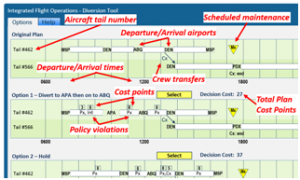In conjunction with the FAA, we have been characterizing the human factors issues most important for Information Automation. Information automation is defined as automation devoted to the management and presentation of relevant information to flightcrew members. Certain human factors issues and pilot errors which might be prevalent in interacting with information automation may be minimal for other types of automation. We developed the Development and Analysis of Characteristics of Automation Types (DACAT) method to enable designers and evaluators of automation to determine the most important characteristics for a type of automation in a given domain.

Based on this work, MS student Rachel Dudley developed a decision-support tool to assist a pilot in making decisions of when and where to divert a flight. The decision aid enabled pilots to take a more active role in considering the impact of a diversion decision on downstream airline operations such as schedules for aircraft, crew, maintenance, and passengers. We studied the interaction between information quality, automation processing visibility, and display complexity. We demonstrated that poor information quality appeared to be difficult for pilots to detect, even when presented with high automation visibility. However, trust in automation was reduced by low information quality, but compensated for by increased automation visibility. Added information to help pilots understand information automation state and outputs, given a level of information quality, should be balanced against potential increases in pilot workload due to the time and attention needed to process the extra information. We developed recommendations and guidelines that can be passed on to manufacturers to improve the displays, or used by the FAA to form certification methods and standards.
